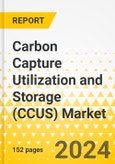Upcoming Policies Will Create Opportunities for CCUS Technology
10% Free customization
Carbon capture utilization and storage (CCUS) market is experiencing significant growth, propelled by favorable government policies driving the deployment of CCUS technology, increasing demand for CO2 for enhanced oil recovery (EOR) and rise in adoption of net-zero emissions targets. Considering the optimistic scenario the market is valued at $3.67 billion in 2024 and is expected to grow at a CAGR of 24.32% to reach $32.04 Billion by 2034.This report comes with 10% free customization, enabling you to add data that meets your specific business needs.
Despite these positive drivers, the market faces hurdles such as CO2 leakage from the underground storage reservoirs. However, increasing investment to setup new industrial plants in growing economies present lucrative opportunities for the expansion of carbon capture utilization and storage (CCUS) demand, suggesting a vibrant future for this market as it navigates through challenges towards high initial cost of carbon capture utilization and storage process.
At present, North America is the prominent region utilizing CCUS, followed by Europe. The growing government initiative for the development and deployment of CCUS coupled with increasing adoption of net-zero emission targets is propelling the market growth. Moreover, CO2-EOR is a major economic driver for CCUS deployment in the Americas, and much of the current policy and legal and regulatory landscape is focused on incorporating CCUS into prevailing oil and gas regulations at both the federal and state levels. Moreover, the Europe Union’s (EU’s) net-zero goal for 2050 is primarily focusing on the elimination of GHG emissions. Therefore, despite the undefined public acceptance of the technologies, CCUS is expected to remain an important means of reducing carbon emissions. The demand for CCUS has also been rising in the Asia-Pacific region, owing to rising CO2 emissions.
CCUS plays an essential role in the transition to a prosperous net-zero economy. The global community has been actively promoting cooperation to address climate change. Carbon capture utilization and storage (CCUS) is one of the key technologies to achieving global climate and energy goals. According to IEA, CCUS is the only solution for tackling emissions from heavy industry sectors, including cement. In order to achieve carbon neutrality and to promote the development and deployment of decarbonization technologies, governments of various countries and ministries are coming up with targets and policies which will create opportunities for CCUS. In 2022, Indonesian Energy Minister and Japanese Industry Minister signed a memorandum of cooperation (MoC), aimed to collaborate in the development and deployment of decarbonization technologies such as CCUS. In December 2023, Canada unveiled its Carbon Management Strategy aimed at facilitating access to capital for projects focused on carbon management. As part of this strategy, the federal government introduced the refundable Carbon Capture, Utilization, and Storage Investment Tax Credit (CCUS ITC), valued at $3.1 billion over the initial 5-year period. This tax credit will remain accessible for investments spanning from 2022 to 2040, with rates gradually decreasing post-2030 to encourage early investment.
Market Segmentation:
Segmentation 1: by Application
- Oil and Gas Industry
- Power Industry
- Chemicals and Petrochemicals
- Cement Industry
- Steel Industry
- Others
Segmentation 2: by Technology
- Pre-Combustion Carbon Capture
- Post-Combustion Carbon Capture
- Oxy-Fuel Combustion Carbon Capture
- Direct Air Capture
- Others
Segmentation 3: by Type
- Voluntary
- Compliance
Segmentation 4: by Region
- North America
- Europe
- Asia-Pacific
- Rest-of-the-World
Table of Contents
Executive SummaryScope and DefinitionMarket/Product DefinitionKey Questions AnsweredAnalysis and Forecast Note6. Research Methodology
1. Markets: Industry Outlook
2. Carbon Capture Utilization and Storage (CCUS)(by Application)
3. Carbon Capture Utilization and Storage (CCUS) (by Product)
4. Global Carbon Capture Utilization and Storage (CCUS) (by Region)
5. Companies Profiled
Companies Mentioned
- Fluor Corporation
- ExxonMobil Corporation
- Linde plc
- Shell plc
- Mitsubishi Heavy Industries, Ltd
- JGC Holdings Corporation
- Equinor ASA
- Schlumberger Limited
- Aker Carbon Capture
- Carbon Clean Solutions Limited
- C-Capture
- Halliburton
- Siemens
- Hitachi, Ltd
- Honeywell International Inc








